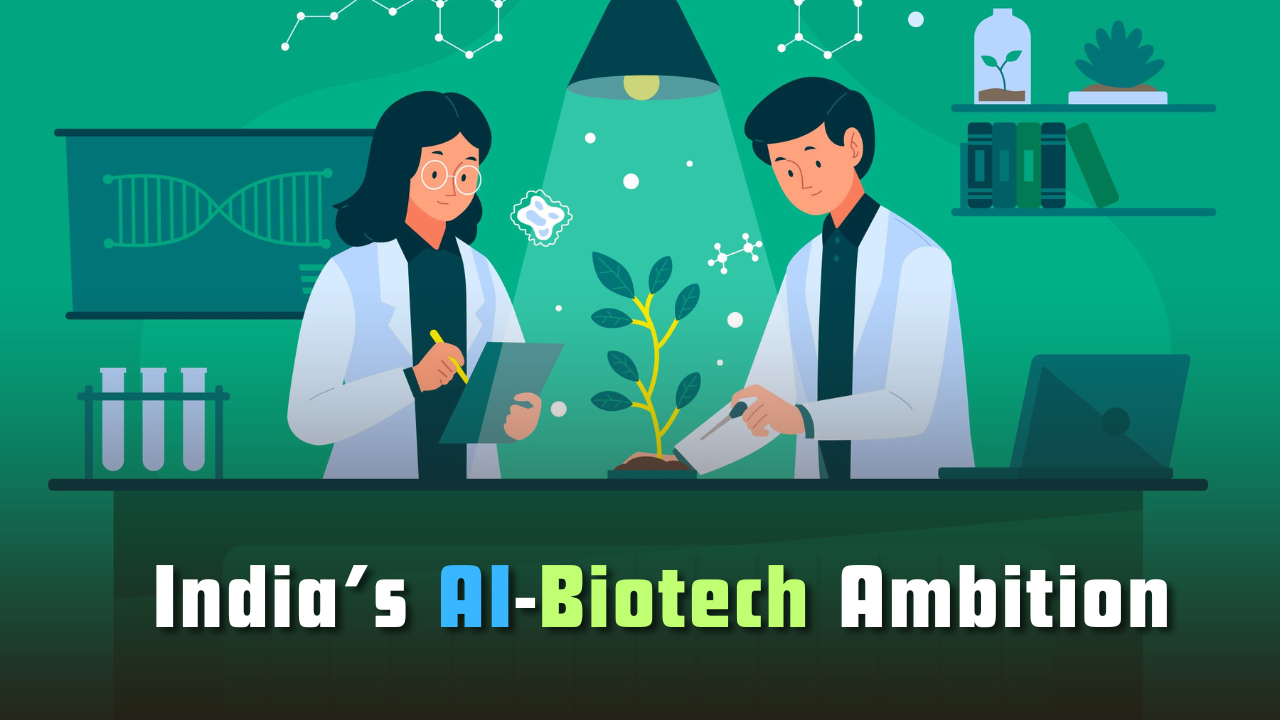Font size:
Print
India’s AI-Biotech Ambition
AI and biomanufacturing: can India’s policies match its ambitions?
Context: India is aiming to become a global leader in AI-driven biotechnology, backed by bold initiatives like the BioE3 Policy (2024) and the IndiaAI Mission.
More on News
- Biomanufacturing is moving from traditional systems to AI-augmented environments featuring robotics, biosensors, and predictive analytics.
- AI optimises complex processes like fermentation, quality control, and drug design, resulting in higher efficiency, lower costs, and better compliance with global standards.
Biomanufacturing: AI Transforming the Sector
- India has traditionally led in generic medicines and vaccines due to its scale, cost, and reliability. Now, AI is transforming the biomanufacturing landscape:
- Biocon uses AI for drug screening and biologics production; enhancing fermentation efficiency and cost control.
- Strand Life Sciences applies AI in genomics and personalised medicine, enabling faster drug discovery and diagnostics.
- AI systems optimise everything from fermentation to packaging using:
- Real-time data from biosensors
- Digital twins to simulate and optimise entire production lines
Why It Matters?
- India has long been the world’s pharmacy, producing 60% of global vaccines and excelling in generic medicines.
- AI integration can:
- Cut down production costs
- Reduce batch failure and waste
- Ensure consistent, high-quality output
- Accelerate drug development
- Improve rural healthcare through personalised diagnostics
Government-Led Initiatives
- The BioE3 Policy, launched in 2024, envisions state-of-the-art biofoundries and “Bio-AI Hubs” to unite India’s scientific, engineering, and AI talent.
- The IndiaAI Mission champions ethical and explainable AI, funding projects that address algorithmic bias and develop “machine unlearning” protocols.
- Funding mechanisms are in place for both startups and established companies to scale AI applications from labs to markets.
AI Applications Beyond Manufacturing
-
AI is transforming the entire biotech and healthcare value chain:
- Drug discovery: In silico compound screening
- Molecular design: Precision optimisation of drug candidates
- Clinical trials: Faster patient recruitment, better trial designs
- Supply chains: Predictive maintenance, demand forecasting
-
Notable Indian players:
- Wipro: AI for reducing drug candidate discovery time
- TCS: Advanced Drug Development platform for clinical trials and outcome prediction
What Are the Challenges?
- Regulatory Vacuum: Existing drug laws not suited for AI-based tools or automated manufacturing. No clear norms for model validation, risk stratification, or dataset diversity.
- Data Governance Gaps: The 2023 Data Protection Act doesn’t address AI-specific concerns in biomanufacturing. Need for clean, diverse, and unbiased datasets across regions.
- IPR Uncertainties: Legal confusion over ownership of AI-invented drugs, molecules, and algorithms.
- Urban Bias Risk: AI tools trained on urban data may fail in rural contexts (e.g., differences in temperature, water quality, infrastructure).
What Are Global Best Practices India Can Learn From?
- Internationally, the regulatory landscape is evolving fast.
- The EU AI Act, effective since August 2024, classifies AI applications into four risk tiers, imposing strict requirements on high-risk tools such as those used in genetic editing.
- In the U.S., the FDA’s 2025 guidance outlines a seven-step framework for evaluating AI tools, with key provisions like “Predetermined Change Control Plans” enabling iterative updates to critical AI systems — vital for dynamic fields like cancer treatment.
- India, by contrast, lacks a risk-based, context-aware regulatory framework. This gap could have serious consequences.
- Example: An Indian startup creates an AI tool for enzyme production based on urban plant data.
- Tool fails in semi-urban/rural areas due to unaccounted factors (e.g., water quality, temperature).
- Consequences: Failed batches, economic loss, and reputational damage
- Lesson: Regulatory frameworks must require diverse, representative datasets and clear use-context evaluation.
- Example: An Indian startup creates an AI tool for enzyme production based on urban plant data.
Way Forward
- To realise its vision, India must act on three fronts:
- Build a risk-based, adaptive regulatory framework — Define AI’s context of use, set standards for data and validation, and allow for iterative system improvements, especially in high-risk applications.
- Invest in decentralised infrastructure and talent — AI innovation must not remain confined to metro hubs; rural and tier-2 cities must also benefit and contribute.
- Foster collaborative ecosystems — Government, academia, industry, and global partners must co-create best practices and share lessons.
Subscribe to our Youtube Channel for more Valuable Content – TheStudyias
Download the App to Subscribe to our Courses – Thestudyias
The Source’s Authority and Ownership of the Article is Claimed By THE STUDY IAS BY MANIKANT SINGH




